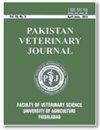LRRK2 Kinase Plays an Important Role in the Intracellular Survival of Brucella abortus 2308 in Murine Macrophages and in a Mouse Infection Model
IF 5.4
3区 农林科学
Q1 VETERINARY SCIENCES
引用次数: 1
Abstract
Received: Revised: Accepted: Published online: December 28, 2018 February 23, 2019 March 08, 2019 April 06, 2019 Brucella species are facultative, intracellular bacteria that cause serious diseases in animals and people. Persistent survival inside macrophages is a major cause of chronic infections with Brucella. Leucine-rich repeat kinase 2 (LRRK2), a large multidomain protein kinase, is associated with Parkinson’s disease, chronic inflammation and intracellular infections. Hence, we monitored the activation of the LRRK2 kinase in Brucella-infected cells and evaluated the function of LRRK2 kinase in the intracellular survival of Brucella. Our results show that Brucella abortus 2308 activated the LRRK2 kinase and that the kinase activity was inhibited by a LRRK2-specific inhibitor in a dose-dependent manner. LRRK2 silencing significantly increased the Th1 immune response and reduced the replication of Brucella abortus 2308, both in vitro and in vivo. LRRK2 also enhanced the phosphorylation level of Akt, thereby inhibiting Akt-mediated humoral immune responses during Brucella infection. Collectively, these findings confirm that LRRK2 acts to reduce innate immune responses by activation of PI3K-Akt pathway, thereby contributing to the intracellular survival of Brucella abortus 2308 in murine macrophages and in a mouse infection model. Therefore, LRRK2 kinase play a key role in infections with Brucella abortus 2308, which will provide new insights into the pathogenic mechanisms used by Brucella. ©2019 PVJ. All rights reservedLRRK2激酶在小鼠巨噬细胞和小鼠感染模型中流产布鲁氏菌2308细胞内存活中起重要作用
接收:修订:接收:在线发布:2018年12月28日2019年2月23日2019年3月08日2019年4月06日布鲁氏菌是一种兼性的细胞内细菌,可引起动物和人类的严重疾病。巨噬细胞内持续存活是布鲁氏菌慢性感染的主要原因。富亮氨酸重复激酶2 (LRRK2)是一种大型多结构域蛋白激酶,与帕金森病、慢性炎症和细胞内感染有关。因此,我们监测了布鲁氏菌感染细胞中LRRK2激酶的激活情况,并评估了LRRK2激酶在布鲁氏菌细胞内存活中的作用。我们的研究结果表明,流产布鲁氏菌2308激活了LRRK2激酶,并且该激酶活性被LRRK2特异性抑制剂以剂量依赖的方式抑制。LRRK2沉默显著增加Th1免疫应答,减少流产布鲁氏菌2308在体外和体内的复制。LRRK2还增强了Akt的磷酸化水平,从而抑制了布鲁氏菌感染期间Akt介导的体液免疫反应。综上所述,这些发现证实LRRK2通过激活PI3K-Akt通路来降低先天免疫应答,从而促进了流产布鲁氏菌2308在小鼠巨噬细胞和小鼠感染模型中的细胞内存活。因此,LRRK2激酶在流产布鲁氏菌2308感染中发挥了关键作用,这将为布鲁氏菌的致病机制提供新的见解。©2019 PVJ。版权所有
本文章由计算机程序翻译,如有差异,请以英文原文为准。
求助全文
约1分钟内获得全文
求助全文
来源期刊

Pakistan Veterinary Journal
兽医-兽医学
CiteScore
4.20
自引率
13.00%
发文量
0
审稿时长
4-8 weeks
期刊介绍:
The Pakistan Veterinary Journal (Pak Vet J), a quarterly publication, is being published regularly since 1981 by the Faculty of Veterinary Science, University of Agriculture, Faisalabad, Pakistan. It publishes original research manuscripts and review articles on health and diseases of animals including its various aspects like pathology, microbiology, pharmacology, parasitology and its treatment. The “Pak Vet J” (www.pvj.com.pk) is included in Science Citation Index Expended and has got 1.217 impact factor in JCR 2017. Among Veterinary Science Journals of the world (136), “Pak Vet J” has been i) ranked at 75th position and ii) placed Q2 in Quartile in Category. The journal is read, abstracted and indexed internationally.
 求助内容:
求助内容: 应助结果提醒方式:
应助结果提醒方式:


